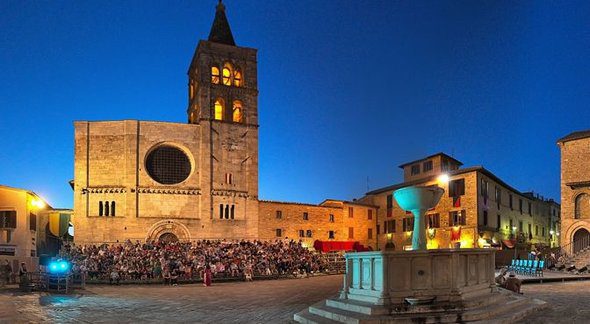La Chiesa di San Michele Arcangelo risale al XII secolo ed è opera degli architetti Binello e Ridolfo. Venne edificata nel luogo in cui sorgeva un antico oratorio nel 1070, soltanto qualche anno più tardi rispetto alla Chiesa di San Silvestro, realizzata dagli stessi architetti.
Si trattò della prima cattedrale della città di Bevagna, abolita poi nel 1248 da Federico II e in seguito ripristinata da Papa Paolo V nel 1620.
![]()
La facciata costituisce la parte meglio conservata dell’intera opera; l’interno mantiene i caratteri romanici dell’impianto originario ma ha subito un profondo rinnovamento nel 1741 in stile barocco e un importante intervento di ripristino fra il 1951 e il 1957. Quest’ultimo restauro fu voluto proprio per liberare il complesso dagli apparati aggiunti nel Settecento e riportare alla luce l’aspetto medievale più antico, sebbene molto dell’originale andò comunque perduto.
La facciata in blocchi di travertino venne realizzata riutilizzato materiale romani di reimpiego, tra cui le stesse decorazioni del portale. L’arco esterno, presenta un’affascinante decorazione a mosaici cosmateschi.
Sono tipiche decorazioni umbre il rosone incorniciato dalle lesene che non si interrompono sulle arcatelle orizzontali e le trifore poste in corrispondenza delle navate laterali. La pianta presenta le tre navate e coro absidato al di sopra della cripta. Quest’ultima è costituita da dodici campate, determinate a loro volta da sei sottili colonne.
Di seguito una piccola gallery della Chiesa, con il dettaglio del portale e l’interno:
![]()
![]()
![]()
The Church of St.Michael Arcangel, which was built in the 12th century only a few years later than the church of St. Sylvester shares its architects: Brunello and Ridolfo.
The facade is very probably the best-conserved part of the whole building, even if the interior still preserving its Romanic characteristics, has undergone restoration from 1951 to 1957. Typical Umbrian decorations are the rose-windows framed by pilaster strips which are not interrupted along the small horizontal arches and the windows woth three lights placed in corrisponding to the lateral naves.
The Church of St.Michael Arcangel, which was built in the 12th century only a few years later than the church of St. Sylvester shares its architects: Brunello and Ridolfo.
The facade is very probably the best-conserved part of the whole building, even if the interior still preserving its Romanic characteristics, has undergone restoration from 1951 to 1957. Typical Umbrian decorations are the rose-windows framed by pilaster strips which are not interrupted along the small horizontal arches and the windows woth three lights placed in corrisponding to the lateral naves.
The Church of St.Michael Arcangel, which was built in the 12th century only a few years later than the church of St. Sylvester shares its architects: Brunello and Ridolfo.
The facade is very probably the best-conserved part of the whole building, even if the interior still preserving its Romanic characteristics, has undergone restoration from 1951 to 1957. Typical Umbrian decorations are the rose-windows framed by pilaster strips which are not interrupted along the small horizontal arches and the windows woth three lights placed in corrisponding to the lateral naves.
The Church of St.Michael Arcangel, which was built in the 12th century only a few years later than the church of St. Sylvester shares its architects: Brunello and Ridolfo.
The facade is very probably the best-conserved part of the whole building, even if the interior still preserving its Romanic characteristics, has undergone restoration from 1951 to 1957. Typical Umbrian decorations are the rose-windows framed by pilaster strips which are not interrupted along the small horizontal arches and the windows woth three lights placed in corrisponding to the lateral naves.



Comment (0)